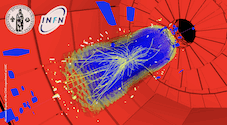Speaker
Description
Summary
Cutting edge research in the treatment of tumours has oriented itself towards hadron therapy, one of the most effective external radiotherapy techniques, that uses charge particle beams (protons and carbon ions) with energy up to 400 AMeV. Such beams make it possible to release accurately the required dose to control the cancerous mass while at the same time leaving the surrounding healthy tissue almost totally untouched. If the maximum advantage is to be made of the potential of these beams, this property must be accompanied by information on the stopping power of the particles used for radio-therapy treatments.
The direct use of these informations, rather than that from X-ray tomography, leads to a more accurate evaluation of the distribution of the dose. The radiographies transmitted can then be used to verify the positioning of the patient and, therefore, the availability of very accurate systems of imaging is of fundamental importance.
The prefixed tasks were to design and build an imaging system for charged particles based on the consolidated principle of the residual range measurement, taking advantage of new detection techniques. The aim is to use this system to reach great dimensions (up to 40x40 sq cm), suitable for almost all medical physics applications, and high spatial resolution (up to approximately 100 micron) and time resolution (up to 5 ns) mainly employing scintillating optical fibers for the trackers and for the residual range measurement, coupled to multi-anode photomultipliers.
It is possible to reduce the number of channels (up to 20 times) both for the tracker and the hodoscope employing an innovative idea.
In order to reach the prefixed objectives and to determine the main choices, accurate simulations of the detector and a precise characterization of the different types and dimensions of commercially available scintillators have been performed. Studies have been carried out on the techniques of cutting and manipulating the fibers, on the preparation of the scintillating layers and on the optical coupling of these with photo-sensitive detectors. It has been also necessary to study the optimization of the construction and mechanical assembly of this delicate set of devices. The developed prototypes have been accurately tested with radioactive sources and particle beams, which are available, at the INFN Laboratorio Nazionale del Sud (LNS). The test results have been useful for the optimization of the final detector.

